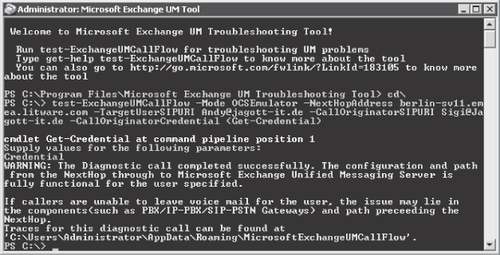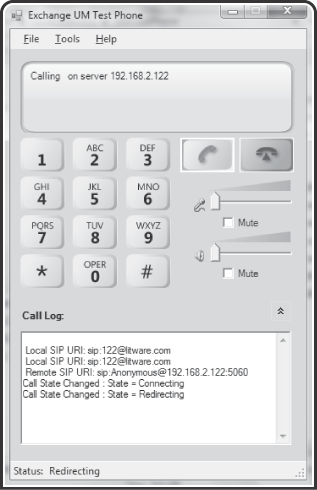3. Testing Unified Messaging Functionality
Testing the UM functionality is a
bit trickier than testing other features such as message routing
because it involves multiple components in the testing process such as
voice, mailbox access, and so on. Only when testing this functionality
end-to-end can you make sure it is working as expected. Several tools
are available for testing your UM functionality.
3.1. UM Troubleshooting Tool
The UM Troubleshooting Tool
is available with Exchange 2010 SP1 as a separate download to
proactively test the voice mail functionality and identify any issues.
The Troubleshooting Tool is able to simulate a call from OCS or IP
gateway to your UM server and verifies that the UM communication is
working as expected. It verifies that a call can be established,
verifies that the audio flow from the UM server works, and prepares
quality metrics for recorded audio.
You can install the UM
Troubleshooting Tool on a workstation or server. The recommendation is
to use an administrative workstation. It is available in x86 and x64
versions and requires the following prerequisites to be installed:
The UM Troubleshooting Tool provides you with a shell similar to the EMS and allows you to test UM connectivity with the Test-ExchangeUMCallFlow cmdlet, as shown in Figure 3.

If you want to use the UM Troubleshooting Tool to test your UM server, you need to create the following:
A UM dial plan with Telephone Extension as the URI type and Unsecured as VoIP security
A UM IP gateway that points to the IP address of the workstation you installed the UM Troubleshooting Tool on
A UM-enabled mailbox with an extension
After you create the prerequisites, run the Test-ExchangeUMCallFlow –Mode GatewayEmulator –VoIPSecurity Unsecured –NextHopAddress <UMServer> -Diversion <Extension> cmdlet to verify that the UM server is working correctly.
Note:
You can use this tool to run against Exchange 2010 UM SP1 servers only!
3.2. Exchange UM Test Phone
The Microsoft
Exchange UM Test Phone is a software phone that you can use to connect
to your UM server and simulate specific IP gateway settings. It is
based on the Exchange Speech Engine and can be used to troubleshoot
connectivity.
The UM Test
Phone (ExchangeUMTestPhone.exe) is no longer available on the Exchange
2010 DVD, but you can get it from an Exchange 2007 DVD and use it
against your Exchange 2010 UM server.
Note:
UM
uses the Unified Communications Managed API 2.0 Core SDK (UCMA) in
Exchange 2010 SP1; the Exchange UM Test Phone cannot connect anymore to
run against SP1. You can only use it with Exchange 2010 RTM.
You can install the
Exchange UM Test Phone on a workstation or server that includes a
microphone and speakers so you can verify that the speech is accurate
and correct. Like the Exchange 2007 installation files, it is available
in x86 and x64 versions. The UM Test Phone is shown in Figure 4.

Detailed information about how to test your UM server with the UM Test Phone can be found at http://technet.microsoft.com/en-us/library/aa997146(EXCHG.80).aspx.